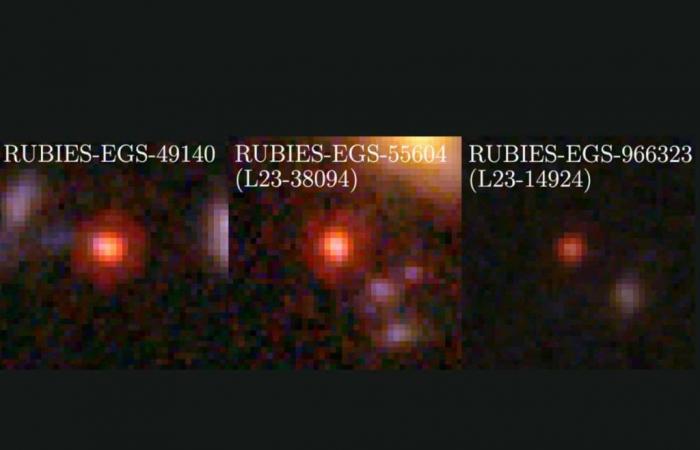⇧ [VIDÉO] You may also like this partner content
Recent observations with the James Webb Space Telescope (JWST) reveal the presence of three strange, extremely massive objects in the early Universe, approximately 600 to 800 million years after the Big Bang. Their spectral signature corresponds to that of hyperdense star clusters potentially harboring supermassive black holes, which is in contradiction with what one would expect from the early Universe.
In 2022, a group of astrophysicists detected three extremely massive objects dating from between 600 and 800 million years after the Big Bang, when the Universe was only 5% of its current age. By studying their spectra, the researchers detected signatures of primitive stars, much older than what should normally be possible in the early Universe, according to the standard cosmological model.
They were also surprised to discover the signatures of extremely massive black holes, between 100 and 1000 times more massive than the black hole at the center of our galaxy. Here again, the process of black hole and galaxy formation according to the standard cosmological model do not match.
An invitation to dream, ready to be worn.
« It’s very confusing ” Joel Leja, assistant professor of astronomy and astrophysics and co-author of the study, said in a press release from Penn State University. “ We can make this fit into our current model of the universe, but only if we are talking about an exotic and incredibly rapid formation at the beginning of time. “, he explains.
Indeed, while researchers initially suspected that these were massive and early galaxies, this type of object should in fact not be able to form in the early Universe. Feedback processes induced by star formation generally limit their fraction of baryons (composite particles making up visible matter) well below the fraction of cosmic baryons. This means that the objects in question would both have appeared earlier than estimated and would represent more mass than expected.
The new study, recently published in The Astrophysical
Journal Lettersis a continuation of this research, aimed at confirming the true nature of these objects. The researchers found that, in fact, these are galaxies close to the beginning of the Universe that seem to house gigantic supermassive black holes.
« It was totally unexpected to find old stars in such a young universe. Standard models of cosmology and galaxy formation have been incredibly successful, but these luminous objects don’t quite fit into these theories “, explains the lead author of the study, Bingjie Wang.
Small galaxies harboring “supermassive” black holes?
To carry out their observations and analyses, the researchers in the new study relied on the Near InfraRed Spectrograph (NIRSpec) on board the JWST and the Roar supercomputer from the Institute for Computational and Data Sciences at Penn State University. NIRSpec is a multi-object spectrograph which makes it possible to simultaneously obtain the spectra of more than a hundred objects per 3’x3′ field of view with various
resolutions spectral. The instrument can go back as far as 13.5 billion years ago, to the beginning of the Universe.
However, even with the resolution of JWST, spectral analyses this far out into the Universe are a major challenge, as it is difficult to accurately distinguish the source objects. The three objects studied by the team clearly exhibit characteristics of supermassive black holes and massive, old stars. However, it is not clear what fraction of the observed light comes from each of the two components. In other words, it is difficult to differentiate between the light coming from the black hole accretion disk and that emitted by the stars that make up the objects studied.
According to the researchers, the data indicates that these could be either primitive, extremely massive galaxies that formed much earlier than models predict, or standard mass galaxies with “supermassive” black holes (or “overmassive blackhole”) approximately 100 to 1,000 times more massive than those of a galaxy of equivalent size. “
The inability to differentiate in the current data leaves much room for interpretation of these intriguing objects. “, Wang says.
See as well
Left: sources detected by the continuum with Balmer breaks (measuring the total luminosity emitted by massive stars), represented by solid diamonds on the color plane. Right: Color images of the three sources detected by Balmer ruptures, with colors from JWST/NIRCam F115W, F277W and F444W. They are remarkably compact at red wavelengths, with some evidence of spatial structure at blue wavelengths. © Bingjie Wang et al.
Extremely dense stellar populations
If some of the light does come from supermassive black holes, they would not be conventional supermassive black holes either. Indeed, they produce many more ultraviolet photons than normal. Other objects with similar photonic characteristics have been previously detected, but they do not exhibit the properties of a supermassive black hole.
On the other hand, the most surprising thing would be their incredibly high mass, according to the researchers. Normally, galaxies and the supermassive black holes at their centers evolve together throughout their lives. However, the black holes detected by researchers appear to be at the centers of small galaxies even though they have reached maturity and appear fully formed. “ This doesn’t really make sense, because these objects should evolve together, or at least that’s what we thought », estimates Leja.
In addition, the stellar populations there are so dense that they could only have formed under conditions that were particularly exotic for the time. If this stellar density were transposed to our galaxy, the star closest to Earth would be in our solar system, while the supermassive black hole at its center would be only 26 light years away (compared to 26,000 light years in reality) and would be visible in the sky as a giant pillar of light. Furthermore, these intriguing galaxies seem specific to the early Universe, because their formation apparently stopped after only a few billion years for some mysterious reason.
In the near future, the researchers plan to extend their observations by pointing the telescope at these objects for extended periods. This would allow them to confirm whether they are primitive, extremely massive galaxies or normal-mass galaxies with “supermassive” black holes.






